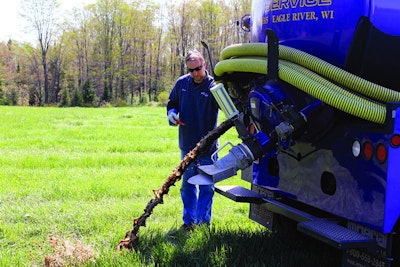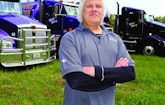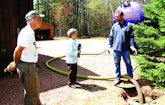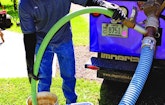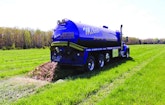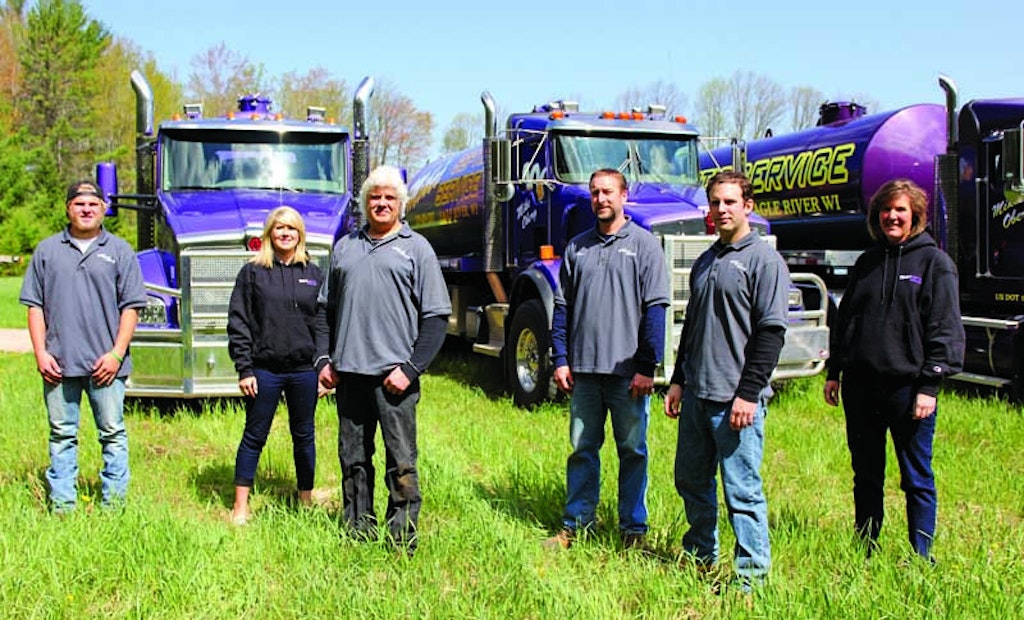
Interested in Trucks?
Get Trucks articles, news and videos right in your inbox! Sign up now.
Trucks + Get AlertsAfter more than two decades in the pumping business, Mike Oberg relies on a simple principle he started out with: Treat your customers and employees well, and remember the two are inextricably connected to one another.
Running a successful small business is just that simple for Oberg, 53, who started Mike’s Septic Service in 1993 in Eagle River, Wisconsin, after spending many years working for another pumping company.
“The only way you’re going to get good employees is by treating them fairly,” Oberg says. “And if they’re happy with their job, they’re going to treat the customer better. If they’re not happy, that attitude will run right over to the customer.”
LEARNING THE ROPES
Oberg was only 14 when he got his first taste of the septic pumping business. It was the summer following eighth-grade, and Oberg and his twin brother had been working at a campground in Eagle River.
“In the spring — before the campground opened — they needed both of us, but after it got going, they only needed one of us working a day,” Oberg recalls.
“My dad came home one day and said, ‘I have another job for one of you if you want it.’”
The youngster volunteered.
“My dad had said it would be just riding around with a guy in his truck and helping him out. I thought I could do that. Two days later, a septic truck pulled into the yard. I said, ‘What’s that here for?’ My dad said, ‘Well, that’s your job.’”
For Oberg, it was a learning experience and eventually brought him to his current status as a small-business owner.
“I learned how to do the job — how to do the work, how to locate tanks,” Oberg says. “In the beginning, I was young and it didn’t really matter how much money I made. But as time went on, I had a family and was raising kids, and I needed more. I had two choices: Quit and find some other type of job or go into business for myself.”
RESPECT IS THE KEY
Oberg says his customer service philosophy isn’t complex.
“You just treat people with respect,” he says. “Not that the customer is always right, but you want to give customers the best service you can.” Oberg says that means doing jobs the right way and not taking shortcuts. He won’t pump through vent pipes and whenever possible backflushes in order to pump tanks more thoroughly.
“Not everyone will do that, but customers appreciate it,” Oberg says.
That doesn’t mean Mike’s Septic Service has never encountered an unsatisfied customer. Oberg recalls one recent job in which a customer was angry about an aluminum hose collar scratching the blacktop of his driveway. With the amount of hose that was needed to reach the tank, Oberg says there was little that could’ve been done to prevent that from happening. All you can do is be polite in your explanations to customers and accommodate them whenever possible, he says.
“You do the best you can,” Oberg says. “In that case, there was nothing I could do.”
On another job a few years ago, Oberg remembers one of his drivers leaving tracks in a driveway after pumping a tank. The driver called Oberg immediately and Oberg went to the home to assess the damage.
“I called my insurance company, said we just damaged a driveway, and gave them the customer’s name and number,’’ Oberg recalls. The proactive approach left a great impression with the customer. “He was happy as heck. That section of blacktop we damaged was only two weeks old. If he would have told us that, we wouldn’t have come in the driveway. But you accommodate people when you can.”
That accommodating attitude extends to Oberg’s employees.
“I try to make sure they get the time off when they need it, I pay them a good wage, and I make sure they have good equipment and proper training so they’ll be able to do their jobs the right way,’’ he says. “Every year, we have a Christmas party. I try to make sure I have something for them in the summertime too. If they need to borrow the skid-steer or use my pickup truck for something, they’re welcome to it. It’s just a good working relationship.”
A FIT FLEET
Oberg has gradually grown the business. What began as a one-man operation now employs a crew of five covering a 10-county service area in northern Wisconsin and parts of Michigan’s Upper Peninsula, with three trucks on the road daily for most of the year, all Kenworth — a 2010 T800 semi-tractor tanker with a 6,500-gallon tank built out by Central Wisconsin Body and Hoist and a Masport pump; a 2012 T800 tandem-axle with a 4,300-gallon tank and Masport pump built by Imperial Industries; and a 2015 T880 tri-axle with a 5,200-gallon tank and National Vacuum Equipment blower built by Imperial.
Oberg’s crew includes Steve Nobbe and Ike Roberts. Oberg’s daughter, Heather, runs the office and handles customer calls, and Julie LaRiviere does the bookkeeping. Oberg’s son, Spencer, also assists the company, driving to different job sites for tasks such as installing risers or digging up pipes for replacement.
Business slows during the winter months but picks up quickly in the spring as area resorts prepare for the tourist season, part-time residents return to their lake houses and a new batch of homeowners are mailed three-year septic tank service reminders from the county. Oberg says residential work still accounts for the majority of his business, but about 30 percent comes from commercial customers, including restaurant grease trap service.
COST-EFFECTIVE DISPOSAL
Part of Oberg’s customer service approach is being fair about what he charges for his pumping services. At the same time, he says he can’t undercut his competitors and sustain a healthy and profitable business. That means operations need to be as cost-effective as possible. Playing into that goal is Oberg’s practice of land-applying a majority of the waste he pumps.
“The only things I take to the sewer plant are what is required to go, like the holding tanks for the sewer drains of repair shops,” he says. “The land-applying is a lot more cost-effective.”
Fortunately, Oberg has an abundance of farm acreage available to him for land application. When he started the business, a local farmer allowed him to spread on 20 acres of fields. Now Oberg has access to about 150 acres – all owned by the same farmer. With rising prices at the treatment plant ($80 to $100 per 1,000 gallons), Oberg would have to nearly double his pumping fee if he went that route for dumping.
To land-apply, Oberg says he pays the cost to have the hay cut from the fields. The hay yield for the farmer tripled once Oberg began putting those nutrients back into the ground. The more hay that is cut, the more Oberg pays, but he says it’s still far more cost-effective than going to a wastewater treatment plant.
Plus, he maintains a mutually beneficial relationship with the farmer.
“It’s just one farmer, but he has a lot of land,” Oberg says. “He saw the benefit right away and kept giving me more land to spread on.”
Still, there are limits. No more than 39,000 gallons per acre can be spread on the fields annually, and most of that has to be done prior to winter when land application is further restricted. Since the waste goes from tank directly to farmland after being treated with hydrated calcium lime, Mike’s Septic Service has to strike a balance between gallons pumped, acreage available for spreading and the timing for cutting the hay crop.
Oberg says each driver keeps a log of how many gallons are spread and where, and they also consult with one another at the end of each day to stay updated on their totals. They stop spreading on a field two months before the hay is scheduled for harvest, but to be efficient they also try to apply the maximum amount of waste allowed on that field before the cut-off date, Oberg says. For the most part, he says he’s been successful at coordinating pumping and spreading.
“I’m pretty much tapped out,” Oberg says. “If I added another truck — and we’re busy enough that I could — I would need another area where I could spread.”
THE STORAGE ALTERNATIVE
The farmer has more land, but Oberg is searching for property he can purchase and not be so reliant on other landowners. He has also considered storage options to provide flexibility in land application.
“We could store the waste all winter long, and then in the spring take it out to fields. Or if there’s a rainy period and we can’t get out into the fields, we could just put it in the storage tank and take it out when we can,” Oberg explains.
He says storage would also be beneficial for when he eventually does acquire some land, which likely won’t be close enough to allow his employees to constantly shuttle out for disposal and maintain an efficient pumping schedule.
“I was looking at a field, which would be nice, but it’s about 35 miles one way,” Oberg says. “If I had a storage tank, you just dump it in there and I could have one truck just making trips between there and the fields. I could get another truck to do that and still have three trucks out on the road pumping tanks.”
Oberg says it’s just a matter of finding the right storage tank. Ideally, he would like a used 500,000-gallon agriculture slurry tank since that would reduce the engineering costs required for building a new tank. State natural resources officials have told him the permitting process for a large tank would take about two years, and he says finding a large tank in good condition has been challenging.
A NEW ENDEAVOR
While pumping and inspections remain Oberg’s forte, he is considering expanding into portable sanitation; specifically providing high-end restroom trailers.
“Nobody else offers that up here,” Oberg says. “I’ve talked to different people who have tents and do weddings and other events. They say they’d rather have (a trailer than standard portable restrooms).”
In February, Oberg attended the 2015 Water & Wastewater Equipment, Treatment & Transport (WWETT) Show in Indianapolis primarily to look at restroom trailers.
“I did notice there seemed to be more people getting interested in the trailers,” he says. “A lot of women were looking at them. That’s whom it mostly caters to. At a wedding, maybe men wouldn’t mind using a portable (restroom), but women don’t want to have to go in there with their dress on. They might want to have a nicer setup. I thought I’d fill a niche here that others don’t seem to want to do.”
Oberg says he plans on purchasing a medium-sized four-unit trailer and then a second trailer depending on the demand. No matter how that new venture progresses, you can bet Oberg will approach it with the same emphasis on customer service he has practiced with his pumping business over the years.
“You try to make people feel happy about a dirty job you have to do,” he says. “That’s really all there is to it.”
